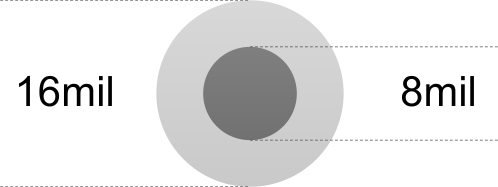JAJSJU6 September 2020 TPS65982DMC
PRODUCTION DATA
- 1 特長
- 2 アプリケーション
- 3 概要
- 4 Revision History
- 5 Pin Configuration and Functions
-
6 Specifications
- 6.1 Absolute Maximum Ratings
- 6.2 ESD Ratings
- 6.3 Recommended Operating Conditions
- 6.4 Thermal Information
- 6.5 Power Supply Requirements and Characteristics
- 6.6 Power Supervisor Characteristics
- 6.7 Adapter Power Switch Characteristics
- 6.8 USB Endpoint Requirements and Characteristics
- 6.9 Analog-to-Digital Converter (ADC) Characteristics
- 6.10 Input/Output (I/O) Requirements and Characteristics
- 6.11 I2C Slave Requirements and Characteristics
- 6.12 SPI Master Characteristics
- 6.13 Single-Wire Debugger (SWD) Timing Requirements
- 6.14 ADP_POWER_CFG Configuration Requirements
- 6.15 Thermal Shutdown Characteristics
- 6.16 Oscillator Requirements and Characteristics
- 7 Parameter Measurement Information
-
8 Detailed Description
- 8.1 Overview
- 8.2 Functional Block Diagram
- 8.3
Feature Description
- 8.3.1 Adapter Power Switch
- 8.3.2 USB Type-C Port Data Multiplexer
- 8.3.3 Power Management
- 8.3.4 Digital Core
- 8.3.5 System Glue Logic
- 8.3.6 Power Reset Congrol Module (PRCM)
- 8.3.7 Interrupt Monitor
- 8.3.8 ADC Sense
- 8.3.9 I2C Slave
- 8.3.10 SPI Master
- 8.3.11 Single-Wire Debugger Interface
- 8.3.12 ADC
- 8.3.13 I/O Buffers
- 8.3.14 Thermal Shutdown
- 8.3.15 Oscillators
- 8.4 Device Functional Modes
- 8.5 Programming
- 9 Application and Implementation
- 10Power Supply Recommendations
- 11Layout
- 12Device and Documentation Support
- 13Mechanical, Packaging, and Orderable Information
11.2.2 Recommended Via Size and Trace Widths
For all LDO voltages, GPIO, Interface (I2C/SPI) and VIN_3V3 a single via connection to the pads on the TPS65982DMC is sufficient. For ADP_IN the current flowing into the device is less than 50mA but it is important to reduce the inductance in the trace. The ADP_IN capacitor is best placed close to the TPS65982DMC. The recommended via is a 16mil diameter / 8mil hole that is filled (epoxy fill or Cu fill) and tented on both sides of the PCB. The tenting will help reduce solder from wicking and lifting the BGA package. Figure 11-4 shows the recommended via size.
 Figure 11-4 Recommended Via Sizing
Figure 11-4 Recommended Via SizingTable 11-1 shows the minimum trace widths. It is recommended to take into account any losses that may be present such as resistance from system supplies to input supply pins (VIN_3V3).
| Signal | Minimum Width (mil) |
|---|---|
| LDO_3V3, LDO_1V8A, LDO_1V8D, LDO_BMC, VIN_3V3, VOUT_3V3, VDDIO, HV_GATE1, HV_GATE2 | 6 |
| GPIO, I2C, SPI | 4 |
| Component GND | 6 |